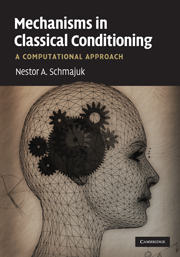Book contents
- Frontmatter
- Contents
- Preface
- Acknowledgments
- Abbreviations
- Part I Introduction
- Part II Attentional and associative mechanisms
- Part III Configural mechanisms
- Part IV Attentional, associative, configural and timing mechanisms
- Part V Conclusion: mechanisms of classical conditioning
- 17 Conclusion: mechanisms of classical conditioning
- References
- Author Index
- Subject Index
17 - Conclusion: mechanisms of classical conditioning
from Part V - Conclusion: mechanisms of classical conditioning
Published online by Cambridge University Press: 23 May 2010
- Frontmatter
- Contents
- Preface
- Acknowledgments
- Abbreviations
- Part I Introduction
- Part II Attentional and associative mechanisms
- Part III Configural mechanisms
- Part IV Attentional, associative, configural and timing mechanisms
- Part V Conclusion: mechanisms of classical conditioning
- 17 Conclusion: mechanisms of classical conditioning
- References
- Author Index
- Subject Index
Summary
This book analyzes attentional, associative, configural and timing mechanisms that are embedded in different computational, neural network theories of classical conditioning.
Part I serves as an introduction to the problem and possible solutions. Chapter 1 briefly introduces a number of well-known conditioning paradigms and describes both theories and computational models that have been proposed to describe and explain them.
Part II concentrates on attentional and associative mechanisms. Chapters 2, 3, 5, 7, 8 and 9 describe an attentional–associative model and apply it to the description of excitatory and inhibitory conditioning, compound conditioning, latent inhibition, overshadowing, blocking, backward blocking, recovery from overshadowing, recovery from blocking, recovery from backward blocking, extinction and creative processes. Chapters 4, 6, 7 and 10 describe the neurobiological mechanisms involved in fear conditioning, latent inhibition, creative processes and extinction.
Part III is devoted to configural mechanisms. Chapters 11 and 12 describe a configural model and apply it to the description of occasion setting. The model provides a very precise description of under what conditions a CS functions as a simple CS or an occasion setter, and how these different functions are mechanistically achieved. In the model, direct and indirect CS–US associations compete, through the same rule that governs blocking, overshadowing and conditioned inhibition, to decide the role of the CS as a simple CS or as an occasion setter. Chapter 13 analyzes the neurobiological bases of occasion setting.
- Type
- Chapter
- Information
- Mechanisms in Classical ConditioningA Computational Approach, pp. 417 - 424Publisher: Cambridge University PressPrint publication year: 2010



